- Manufacturer: Cormoran
- Dimensions: 13 × 3 cm
- www.daiwa-cormoran.info
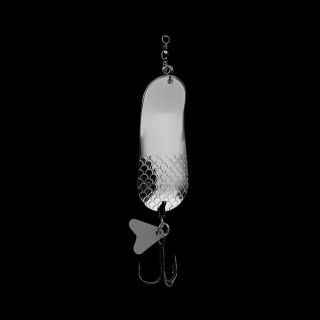
Index
- Meaning A fishing lure is an object attached to the end of a fishing line which is designed to resemble and move like the prey of a fish. The purpose of the l
- History The fishing lure has been around since the time of the earliest humans. They were first made out of bone and bronze. The Chinese and Egyptians used fi
- Production Major vacuum equipment manufacturer ULVAC has announced plans to enter the fishing tackle industry with a new type of lure featuring a nanocoating app
- Fishing Methods The fishing lure is either tied with a knot, or connected with a tiny safety pin-like device called a 'snap' onto the fishing line which is in turn co
- Eat Me Synonyms allurement, ambush, appeal, attraction, bribe, call, camouflage, carrot, come-on, con game, decoy, delusion, draw, enticement, fake, gimmick,
- Reform of a Manly Hobby Keywords: ‘additional masculinities’; rural masculinity; waterscapes; liminality; cadence This article examines the masculinities evident through fly
- Fish Intelligence Do fish think and do they have a brain? "Yes and some are smart enough to learn and retain things. I have had a fish that could recognize me as the f
- Fish Behaviour The main theme of our work concerns the study of spatial cognition in fish – a subject that is key to understanding the survival and success of aquati
- Bling Bling With the ever increasing prices of fishing lures, don't you ever wish you could make your own cheap and easy fishing lures? The answer is here, and it
- Real Fake We have been trying to get the artificial world to resemble the natural world for thousands of years. From the acanthus leaves used to decorate the ca
- Help Never work your spoon, spinner, or plug in a mechanical, unthinking sort of way. Instead, try to make a big predator think that this strange wood, met
A fishing lure is an object attached to the end of a fishing line which is designed to resemble and move like the prey of a fish. The purpose of the lure is to use movement, vibration, and colour to catch the fish's attention so it bites the hook. Lures are equipped with one or more single, double, or treble hooks that are used to hook fish when they attack the lure.
Lures are usually used with a fishing rod and fishing reel. When a lure is used for casting, it is continually cast out and retrieved, the retrieve making the lure swim or produce a popping action. A skilled angler can explore many possible hiding places for fish through lure casting such as under logs and on flats.
There are many types of fishing lures. They are all manufactured in different ways to resemble prey for the fish in most cases, but are sometimes engineered to appeal to a fishes sense of territory, curiosity or anger.
Most lures are made to look like dying, injured, or fast moving fish. They include the following types:
- A jig is a weighted hook with a lead head opposite the sharp tip. They are often covered with a minnow of crawfish or even a plastic worm to get the fish's attention. The operator has to move the rod to get the jig to move.
- Surface lures are also known as top water lures, they float and resemble prey that is on top of the water.
- Spoon lures are made to resemble the inside of a diner spoon. They flash in the light while wobbling or darting due to their shape to attract fish.
- Plugs are also known as crankbaits. These lures have a fishlike body shape and they are run through the water where they can make a variety of different movements caused by instability due to the scoop under the head.
- Artificial flies are designed to resemble all manner of fish prey.
- Soft plastic baits are made out of plastic or rubber and are designed to resemble worms, lizards, frogs, leeches and all other sorts of living creatures in the water.
These fishing lures can be made out of wood, plastic, rubber, metal, cork, and materials like feathers, animal hair, string, tinsel and others. They can have many moving parts and also no moving parts.
One advantage of artificial lures is a reduction in use of bait. This contributes to resolving one of the marine environments more pressing problems, that being the undermining of marine food webs by over-harvesting 'bait' species which tend to occur lower in the food chain. Another advantage of lures is that their use promotes improved survival of fish during catch and release fishing.
The fishing lure has been around since the time of the earliest humans. They were first made out of bone and bronze. The Chinese and Egyptians used fishing rods, hooks, and lines as early as 2,000 B.C. though most of the first fishermen used handlines. The first hooks were made out of bronze which was strong but still very thin and less visible to the fish. The Chinese were the first to make fishing line, spun from fine silk. The modern fishing lure was made commercially in the United States in the early 1900s by the firm of Heddon and Pflueger in Michigan. Before this time most fishing lures were made by individual craftsman.


Major vacuum equipment manufacturer ULVAC has announced plans to enter the fishing tackle industry with a new type of lure featuring a nanocoating applied with special vacuum technology. The high-tech lure, called STROM, has gone on sale online in October 2006.
Relying on a vapor deposition polymerization technique used in semiconductor manufacturing, an optical coating is formed over the entire glossy surface of the lure. The ultrathin optical coating has a high degree of light transmission, giving the lure an iridescent "holographic color" that changes according to the viewing angle.
In tests, anglers using STROM caught 4 times as many fish as those using other commercially available lures. The company claims the lure appeals to freshwater fish such as trout, as well as to reef-dwelling saltwater fish such as rockfish.
ULVAC's initial plans are to roll out two types of STROM lures – one weighing 2.4 grams and one weighing 3.7 grams.
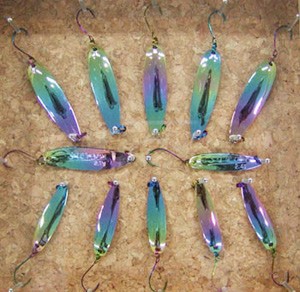
Homemade
There really is nothing like spending time at home, then an hour or two later hitting the road with your new masterpieces. You have put your lure making skills to good use. Now you are ready to do battle at the river or lake. You are the hunter and your ammunition is ready.
The style and size of the different lures you can make really is infinite, from a small spinner to a large floater. The array of colours available really puts the finishing touches, to what really is a stunning work of art. The only difference here is that you will use your creation to catch some eye catching fish.
I spent months looking for the right tools, and wasted countless hours and money on tools and materials that I eventually binned. Hand tools, wood and coating products just to name the things I can remember. Through trial and error I found exactly what I needed. At least I thought so at the time.
Getting together a few basic woodworking tools will enable you to make your own lures for evermore, not ever having to buy another one. Or if you are really eager and ambitious, it's more than possible for you to set up a cottage industry to cover the cost of your materials or even more.
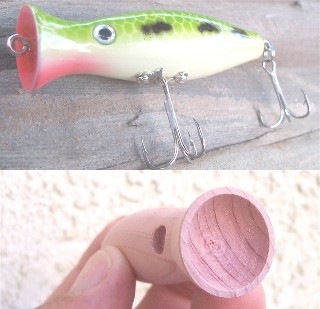
The bait is dead, long live the lure
Motivated by the abolition of living baits Cormoran brought a lure program to the market themed "The bait is dead, long live the lure". This lure program was copied from nature and guarantees – even improves – the success for spin fishing under the brand 'CORA Z' till today.
Even the end of competitive fishing, Cormoran accepted innovatively. Cormoran was the first company which introduced to the fishing community a high-tech equipment.
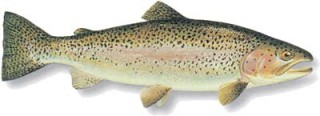

The fishing lure is either tied with a knot, or connected with a tiny safety pin-like device called a 'snap' onto the fishing line which is in turn connected to the reel. The reel is attached to a rod.
There probably are as many fishing techniques and fish-catching tricks as there are anglers on the water, but the how-to aspect of sport fishing boils down to a few basic, tried-and-true fishing methods that have worked for as long as man has been trying to catch fish on a hook and line. If you master these basic methods, you'll become a successful angler.
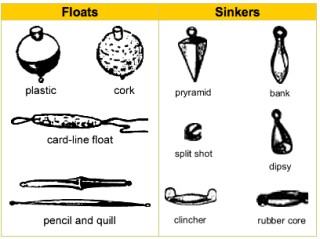
Still-fishing
The simplest of fishing methods can also be the most effective. As its name implies, still-fishing is a matter of putting your bait in the water and waiting for a fish to find it. This method will catch most kinds of fish and can be used from a boat, a dock, a jetty or from shore. Depending on water depth and what you're trying to catch, you may want to still-fish near the surface, at a mid-water depth, or right down on the bottom. Using a float, or bobber, makes it easy to fish near the surface, or you can add sinkers to your line to fish deeper.

Casting
The term 'casting' actually has two meanings in fishing. It describes the act of using a rod, reel and line to carry your bait or lure out into the water. It also is a specific fishing method, as opposed to still-fishing and other methods we'll describe here.
There are times when a moving lure works best, especially for some fish species. At other times you may want to place a lure in a particular spot, such as right next to a submerged stump 30 feet from shore or under a tree that's leaning out over the water. These situations are when casting is the fishing method that offers the best chance of catching fish. It's the kind of fishing where you cast and retrieve, usually with an artificial lure, to fish waters where fish might be lurking and to coax them into striking. Spinners, wobbling spoons, plugs and spinnerbaits are lures commonly used for casting.
Trolling
Many of the lures used in casting also work for trolling, because it's another fishing method that requires movement to be effective. Trolling is simply dragging a lure, bait or a bait-and-lure combination through the water, using a boat rather than casting and retrieving to provide movement.
Jigging
Some artificial lures function best if they're worked through the water in an up-and-down motion, commonly referred to as jigging. Lifting and dropping the rod tip is what provides the jigging motion. Leadheads are the most common kind of jig, but for some fish species, especially saltwater salmon and bottomfish, the jigging lure might be a long, thin, slab of lead or other metal in the shape of a herring or other baitfish.
Fly Fishing
Artificial flies are nothing more than fur, feathers, thread, tinsel and other materials tied around a hook to resemble an insect, a grub, a minnow or some other small morsel that a fish might eat. Because they are often very small and always very light, they can't be cast like a heavy lure. For that reason, they are usually fished with special lines, rods and reels designed just for this kind of fishing.
Synonyms
allurement, ambush, appeal, attraction, bribe, call, camouflage, carrot, come-on, con game, decoy, delusion, draw, enticement, fake, gimmick, hook, illusion, incentive, inducement, inveiglement, invitation, magnet, mousetrap, pull, seducement, seduction, siren song, sitting duck, snare, sweetener, temptation, tout, trap, trick
Antonyms
deterrent, warning
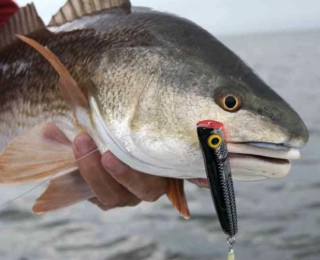
Colour
Fish are always on the look out for food that stands out or looks vulnerable. [...] Many normal lures lose their colour under water and become grey. This tends to blend in with the darker underwater conditions making that lure somewhat ineffective.
However, glowing lures capitalize on low light conditions and tend to stand out and say,"Bite Me!" The bright oranges, blues, violets, yellows, and even greens create a huge contrast between the lure and its surroundings. This helps a fish take notice, and entices it to attack. In fact, many fish species have eyes that select these colours when searching for prey.
Safety
The Hawg Pockets® fishing lure guard protects against dangerous fish hook injuries by keeping the fish hooks as far away as possible from your body and those around you. One's personal fishing safety and the fishing safety of your kids, spouse and fishing buddies should always be foremost in the angler's mind.
According to Dr. Kevin Wakeman of Lutheran General Hospital in Wheaton, Illinois, each Hospital Emergency Room in a heavily fished area treats more than 600 fish hook injury cases per year! That's almost two cases each day! And these hospital visits are for major fish hook puncture injuries!
Don't let you, your fishing buddy, your family or your pet become a fish hook injury statistic!

Keywords: ‘additional masculinities’; rural masculinity; waterscapes; liminality; cadence
This article examines the masculinities evident through fly fishing for salmon and trout in the South West of England. It identifies the way that many accounts of rural masculinities focus on particularly macho traits such as strength, resilience and domination and particular relationships with nature and the environment. Such macho traits are evident in the masculinities of angling - the angler regularly discusses issues of competition and duelling with nature. The trophies of such encounters become significant as they are used to summon life to stories and become crucial in narrating masculinity. However alongside these macho traits are numerous additional masculinities which are in tension with the more macho elements. These 'additional masculinities' become evident in the watery landscapes of angling; as such these waterscapes can be considered as liminal spaces as they enable masculinities to slip and reform. Therefore what emerges is a cadence to masculinity with different subject positions becoming significant in different spaces.
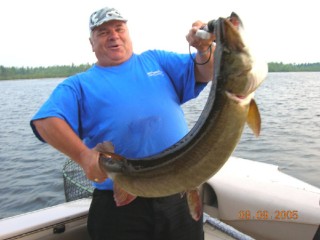
Fishing for All
We are a nonprofit organization that brings women fly fishers together. We support women's fly fishing clubs and individuals. We are a strong and united voice for women to and in the fly fishing industry, and for fly fishing education. Although based in the United States, we are an international organization with a growing membership from around the world and from all socio-economic groups.
Do fish think and do they have a brain?
"Yes and some are smart enough to learn and retain things. I have had a fish that could recognize me as the feeder and did not pay attention to any other person who approached the tank. When I shaved my beard it took it several days to recognize my new appearance. The same fish reasoned a solution to eating snails with hard shells. First it would try to crush the snails in it's throat and this worked for the young thin shelled ones.
The bigger ones it spit back out. Then one day I saw it pick up a small stone with a hard snail and crush the snail against the stone the way I squeeze two walnuts together to crack them. In a few weeks there were no more snails in the tank."
How Intelligent Is Your Fish?
I tested the fish in three different ways: discerning color, number and shapes.
Here is the technique:
1. First, I trained the fish to follow my finger across the outside of the glass, and dropped food into the tank near my finger. This trained the fish to associate that "finger = food."
2. Then, I substituted an 8 cm red cap for my finger, and did the same thing (I used the lid of the TetraMin container). After several weeks, he was able to discern that the "red cap = food." Already, this demonstrated that the fish could make new connections of facts. He can learn!
3. Next, I did a test to see whether he could discern red from brown. First, I placed two small food granules on top of the red disk. With my index finger, I covered the food on the red cap.
I put the index finger of my other hand on the same place on the brown disc - but no food was hidden on that side. Standing about half a meter away from the tank with the two discs close together, I paused for five seconds. Then I moved forward slowly, spreading the caps apart
(I had to look up to avoid watching the fish, so that his movements would not influence me). Whichever circle the fish went to first (within a few centimeters) was his choice. When he was right, I gave him the food; when he was wrong, I did not. When he was wrong, I took the wrong cap away and showed him the right one. I would randomly switch which hand had the red cap. Then every two minutes I would repeat the experiment, five times total each night, recording the results each time.
4. After several weeks, I gave him a final test: five trials in the morning, and five trials in the evening for two days. Could he learn that "red = food" but "brown = no food?" If he could learn that, it would prove that he could distinguish colors as well.
5. Next, I tested if he could distinguish abstract symbols. I put a 3 cm "O" on one 8 cm diameter white paper disc, and a 3 cm "*" on another white paper disc. He only got the food reward if he first approached the "O" disc.
Observations
Overall, the fish succeeded in doing very well on the color test and the shapes test, but not the number test (see graphs). On the color test, the fish got 18 out of 20 tests correct, for an accuracy rate of 90%! Statistically, the odds of him "guessing" the correct color that well were only 1:2500 (see table). In the abstract shapes test, he got 38/50 correct, i.e., he was right 76% of the time. The odds of doing this well just by chance were only 1:5000.
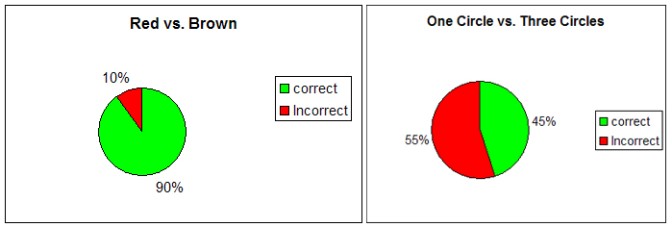
The main theme of our work concerns the study of spatial cognition in fish – a subject that is key to understanding the survival and success of aquatic animals. The ability to orient efficiently through local, familiar areas is central to animals' ability to avoid predation, exploit resources, to reproduce and to reduce competition.
Aquatic habitats are unusual as they are volumes through which animals have three degrees of freedom in their movements. This is unlike most terrestrial environments, in which animals are generally constrained to surfaces. Our long-term aim is to unravel the principles of aquatic orientation by discovering how fish learn and memorise their complex 3D surroundings [...], and how information is sensed through the aquatic medium [...].
We study how different sensory systems gain information from their surroundings and how this sensory information is integrated together. We are particularly interested in how spatial information is acquired using a non-visual sensory system [...], we explore how the lateral line organ of fish gains fine-scale information from the environment [...] We also use blind and eyed morphs of the tetra Astyanax fasciatus to investigate how sensory systems shape the orientation mechanism used by fish.
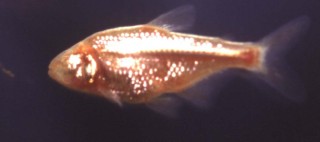
Cognitive Stream
Past research has focused on the way that animals orient across two dimensions and the vertical axis of space has largely been ignored. However, navigating in three dimensions is fundamental to many animals, particularly those that live and move through volumes such as animals that fly or swim. By considering volumes rather than areas, the potential complexity of the environment increases, which in turn, could make the task of successfully navigating far more difficult.
This branch of our research aims to discover how the relatively small-brained fish copes with this problem by testing how fish learn remember and use information from their complex volumetric surroundings, and how they act on this information to orient efficiently.
With the ever increasing prices of fishing lures, don't you ever wish you could make your own cheap and easy fishing lures? The answer is here, and it only takes a bottle cap, two wire rings, and just five minutes of your time. And when you're finished, you can sell them for $1 or more.
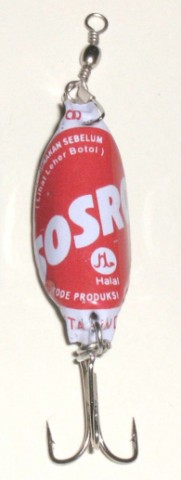
Gold & Diamond Fishing Lures
Offered as a Limited Edition Collector's Series, these numbered lures are the perfect luxury gifts for the affluent sport fisherman...our jewellery fishing lures are crafted in 14-karat gold and diamonds and are the perfect luxury gift for the affluent fisherman or woman. They are used in a variety of ways. Those bold enough may fish with them. Others may wear them as an elegant piece of jewelry, use one as a trendy keychain, an exquisite corporate gift or have them displayed in a cherished keepsake in a shadow box or hung along side a picture commemorating a fabulous fishing trip. Each comes in its own elegant wooden box.
MacDaddy's exclusive men's gifts, such as our #1 Series Engraved Lures, are crafted from sterling silver and plated with 14-karat gold. The fishing lures are then personalized with an engraved inscription, which make these the perfect corporate or exotic gift item for that hard to buy for person in your life.
With our selection of accessories, you can personalize your MacDaddy's Fishing Lure with an original MacDaddy's Accessory. Any one of MacDaddy's lures can be transformed into a stunning necklace, key ring, or displayed in a finely crafted shadow box.

We have been trying to get the artificial world to resemble the natural world for thousands of years. From the acanthus leaves used to decorate the capitals of Corinthian columns to the vertical gardens on today's skyscrapers. The slender stems of Tiffany lamps featured interwoven branches, flowers, dragonflies and spiders' webs. The floral motifs of the Jugendstil, the Art Nouveau movement, were the crowning moment of this pantheistic, psychoanalytical need to feel at one with nature. It was an attempt to radically and totally transform all objects and buildings into forests overgrown with climbing plants. A utopia that was sometimes descriptive and sometimes symbolic: a kind of false imitation of genetics that was if nothing else fantastical in its 'extreme styling', in its ambition to establish a phytomorphic beauty and extend it to infinity. It was also one of the central themes of the ideatorial and didactic principles of Paul Klee. There was an irresistible urge to camouflage.
Bionic
Bionics is the science of copying nature. Actually, those who are researching in bionics get ideas from nature, they don't exactly copy it. [...] Prosthesis is a field which specializes in replacing damaged or defective body parts with artificial ones.
Bionics helped this field with the help of artificial hearts, artificial kidneys, iron-lungs, artificial hands, artificial pacemakers, and others.
In lure coursing, dogs chase an artificial lure across a field, following a pattern that is meant to simulate live coursing.
The lures [...] are attached to the main line and the whole system is driven from a lure machine, a device constructed from a 1955 to 1962 Ford starter motor mounted in a frame. This particular type of starter motor has a long drive shaft upon which is mounted a drive wheel that rather resembles two very sturdy pie plates welded back to back - the line runs in the groove between the plates.

Never work your spoon, spinner, or plug in a mechanical, unthinking sort of way. Instead, try to make a big predator think that this strange wood, metal, or plastic creation is in fact a living, breathing, swimming prey fish!
Look out for all possible hiding places under fallen trees, among weeds, or along the bank. Cast carefully and accurately, and constantly move the rod tip around to create a change of direction.

Weather
Early morning starts are not good for surface lure action! Why? I'll explain, warm sunny days around April and May are usually followed by clear frosty nights cooling the shallow margins and the pike they contain.
Choice of lure is important, of course, but before this, it is vital to locate pike and understand when they will feed in the prevailing conditions. Lure fish in the wrong place at the wrong time and you will remain disillusioned.
- www.thefriendlyfisherman.co.uk/articles/lure-fishing/lure_fishing_tips_and_techniques_articles.asp
- www.thefriendlyfisherman.co.uk/articles/lure-fishing/confidence_with_lures.asp
Casting
- Cast past your target when this is possible. This will help land the lure on the water with as little noise as possible.
- If it is windy, put tension on the line right before the lure touches down on the surface. What this does is straighten out the line and help prevent loose, excess line on the water.
- Lower the lure just a few inches below the rod tip before you cast. What this does is give extra momentum for the cast.
- Never overfill your spool. Ideally, you should fill the spool to an eighth of an inch of the edge of the spool.



































































































